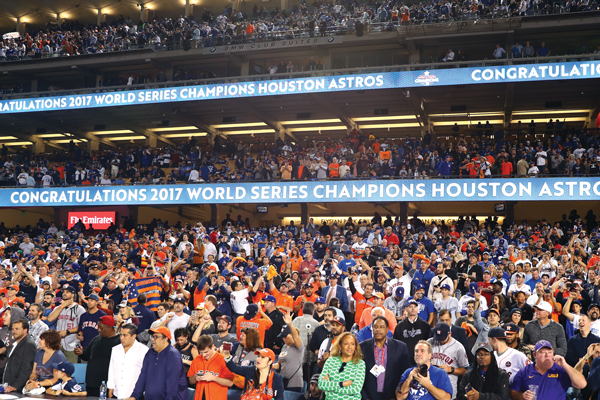It’s no secret that avid sports fans are often maniacally obsessed with their teams.
This intense passion can lead to either a positive effect on the psyche, or serve as a detriment — you’re either basking in the glory for days after a big win, or you’re devastated after a big loss. Oftentimes, that emotional malaise can linger for a few days. Hardcore fans invest so much in their team from an emotional perspective throughout a season that there’s a legitimate feeling of personal loss.
But what’s really interesting is that depending on the score or outcome of a game, this means that millions of fans are in completely different psychological states at the same time. This is a rare phenomenon in our culture when consumers are on completely opposite sides of a win vs. lose outcome, with the obvious notable exception of politics.
From a marketing perspective, that has key implications for how your brand should communicate with its audience. Properties such as ESPN and Bleacher Report have millions of users who have self-identified as being fans of specific teams. Today, brands have the opportunity to engage these kinds of consumers dynamically with customized messaging based on the outcome of games.
But despite the advances in digital products, the vast majority of brands continue to message fans with the same creative.
That needs to change. If brands want to truly capitalize on the passion and intensity of sports fans, then here is what marketers should consider in order to create adaptive, agile programs:
1) Winning vs. Losing: If you were talking to a friend after their favorite team played a big game, would you treat them the same way after a win or loss? Of course not. Like any friend with empathy, you’d congratulate or console them as needed.
In the same way, brands should think about how they can bring their proposition to life in a meaningful way based on the outcomes of games. For example, travel brands have the opportunity to message fans of winning teams in the playoffs by incentivizing them to follow their team into the next round. Conversely, alcohol brands have the opportunity to engage the fans of losing teams with a timely consolation message. Some fans might look to drown their sorrows after a heartbreaking loss.
 |
World Series Game 7 in Los Angeles was a scene of both celebration and heartbreak.
Photo by: GETTY IMAGES
|
2) Before, During, or After: Marketers should always determine if their message will resonate with fans with maximum impact before, during, or after the conclusion of a sporting event. Food brands or restaurant chains typically want to capitalize on the pregame mindset when consumers are stocking up. However, an antiperspirant brand that’s rooted in the benefit of preventing sweat may want to message fans during a close game when they’re more apt to be anxious and perspiring.
3) Matching the Emotional Intensity: It’s not just win or lose — sports fans experience a range of emotions during a game depending on a number of variables. After buzzer beaters or huge upsets, fans’ adrenaline is coursing through their veins. If there is a big game with a division rival, there is a step-change in fan intensity. Now marketers have the opportunity to program customized messages and connect with fans on a more human level based on these different scenarios. Consequently, brands should think about the specific scenarios when their proposition has heightened relevance. For example, a challenger brand could specifically target big upsets given it aligns with their core DNA. Or, a brand embroiled in a fiercely competitive category such as telecom or consumer tech can draft off the heated nature of big division rivalries to land their message in a more profound manner.
4) Contextual Relevance, Minus Some Costs: When marketing around a major sporting event, brands very often have to contend with road blocks given the high costs or exclusive contracts around sponsorships. But there are several ways to create contextually relevant content without incurring the incremental costs of team sponsorship deals. For example, marketers can use the color schemes of teams in their creative without official marketing rights to the team’s marks and logos. In addition, brands can often reference the city name in creative as long as they don’t reference the team name or mascot. If the creative is developed with a templated approach, these connection points to the team can be operationalized at scale with digital publishers so that every ad served to fans is contextual.
5) And If You Do Have Sponsorship Rights: There is a huge opportunity to unleash customized creative with incentive offers for brands who secure official marketing rights to use the intellectual property of teams. For example, if fans are in a “rah-rah” mindset following a big win, marketers can drive purchase through team gear offers acquired via their sponsorship assets — buy a product and get a discount on a team jersey. Specifically, this strategy is perfect with college sponsorship deals given they can be deployed nationally, as opposed to professional team deals, which are typically confined to a geographic radius. It can be especially potent for brands that want to incentivize consumers. For example, companies in the insurance industry that prioritize CRM could offer fans a team gear discount in exchange for providing their email address.
Ultimately, tapping into the psychology of sports fans can be an incredibly powerful weapon for marketers, even though it’s widely under-utilized. If done correctly, whether it’s a win or a loss for your team, brands should always win.
Josh Spiegelman (joshua.spiegelman@mindshareworld.com) is managing director for the Spotlight team (which handles sports and entertainment partnerships) at Mindshare, a global media agency network.





